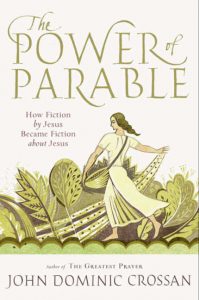John Dominic Crossan “is generally regarded as the leading historical Jesus scholar in the world.” He has been a professor of religious studies at DePaul University since 1969 and currently serves that institution as professor emeritus. Over the last forty years Crossan has written over twenty-five books on the historical Jesus, earliest Christianity, and the historical Paul. Some of his best-sellers include God and Empire: Jesus Against Rome, Then and Now; The Historical Jesus: The Life of a Mediterranean Jewish Peasant; and Jesus: A Revolutionary Biography. He has also co-authored a series of books with Marcus Borg (for my review of Borg’s latest book click here). Crossan lectures around the world and has been interviewed on over 200 radio stations and numerous American television programs.
Book Basics
The Power of Parable is an invitation to reconsider everything one thinks one knows about Jesus’ parables in light of the historical development present within the New Testament. To aid in the exploration of Jesus’ parables and the megaparables more commonly known as Gospels, John Dominic Crossan suggests four classifications: riddle, example, challenge, and attack. To more fully consider the breadth of material available, he divides the book into two sections (“Parables Told by Jesus” and “Parables Told About Jesus”), separated by a brief interlude. Sufficiently scholarly yet readily approachable, this book is certain to be a must read for years to come by all who seek to better understand Jesus’ teaching.
“Part 1: Parables Told By Jesus” begins with chapters considering the three primary classifications (riddle, example, and challenge) that offer definition alongside examples in the Bible (both Old and New Testaments – in varying length: paragraph, chapter, and book) and secular literature. The first half of the book concludes with a chapter that provides additional historical insight and begins to illumine a bridge that is created and crossed in the interlude.
“Part 2: Parables Told About Jesus” provides in-depth considerations of each of the Gospels. These chapters follow a similar format and conclude with an explanation of the classification Crossan deems most appropriate for the given Gospel as a megaparable: Mark is a challenge, Matthew is an attack, Luke-Acts is both an attack (on Judaism) and a challenge (to Rome), and John is an attack (on Judaism) and a challenge (to Empire).
Parable Classifications
Crossan defines the parabolic types thusly:
- “
 Riddle parables (or allegories) are stories in which each element points outside itself to elements in some other hidden story” (p. 244).
Riddle parables (or allegories) are stories in which each element points outside itself to elements in some other hidden story” (p. 244). - Example parables are ethical models, moral cases, or practical instances inviting participation by comprehension and imitation (p. 244).
- Challenge parables are the greatest and most important of the three primarily types: riddle, example, and challenge (p. 47, p.64). These parables “foster not periodic doubting, but permanent questioning” (p.111) that can be seen as attempts “to question ideological absolutes” with the “power of nonviolent rhetoric to oppose violence without joining it” (p. 247).
- Attack parables are those that “move beyond challenging what it opposes to attacking it bitterly and even dismissing it all together” (p.153).
- Jesus relied heavily on parables in his teaching, especially as those teachings are recorded in the Gospels. How might your perspective of the Way of Jesus be enriched by more fully understanding how parables by Jesus became parables about Jesus thanks to the Gospel writers?
- How have you experienced one or more of Jesus’ parables as a challenge in your life? How has struggling with that parable proven helpful to you along your journey of faith?
John Dominic Crossan. The Power of Parable: How Fiction by Jesus Became Fiction About Jesus (HarperOne, 2012). ISBN: 9780061875694.
Read my review of Crossan’s The Greatest Prayer Ever: Rediscovering the Revolutionary Message of the Lord’s Prayer (201o) here.
